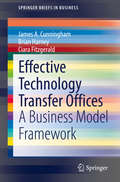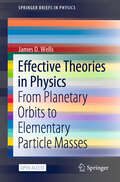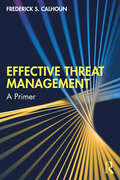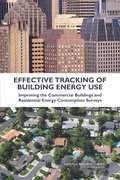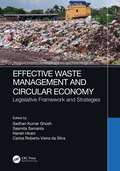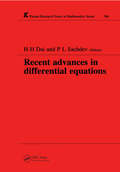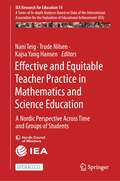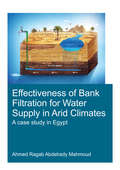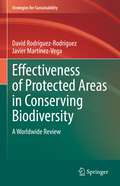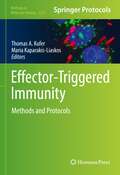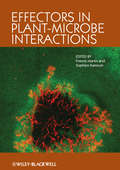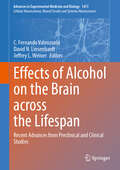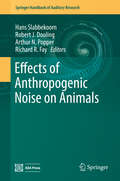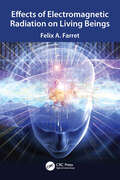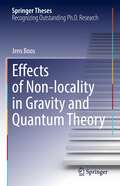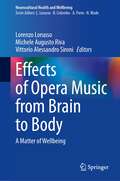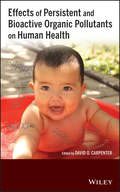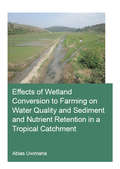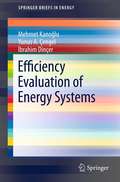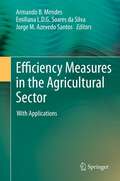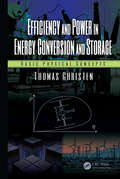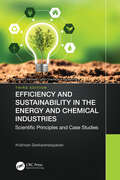- Table View
- List View
Effective Technology Transfer Offices: A Business Model Framework (SpringerBriefs in Business)
by James A. Cunningham Brian Harney Ciara FitzgeraldCombining best practices, empirical studies and the authors’ own research on technology transfer offices (TTOs), technology transfer, ecosystems and scientists in the principal investigator role, this book presents a business model framework for TTOs. From a practitioner’s perspective the business model framework captures key elements of TTOs’ strategic and operational activities that are needed for effective management and leadership. Moreover, the frameworkaddresses central issues including strategy, organisational structure, staff and resources, activities, mechanisms, policy and procedures, and evaluation and outcomes, while also consideringcontextual factors that directly and indirectly affectTTOs, namely thecommercialisation culture and ethos,as well as researchers’ commitment, awareness and motivation. For each element of the framework, the book outlines the key success factors and facilitating factors that enable effective technology transfer.
Effective Theories in Physics
by James D. WellsThere is significant interest in the Philosophy of Science community to understand the role that "effective theories" have in the work of forefront science. The ideas of effective theories have been implicit in science for a long time, but have only been articulated well in the last few decades. Since Wilson's renormalization group revolution in the early 1970's, the science community has come to more fully understand its power, and by the mid-1990's it had gained its apotheosis. It is still one of the most powerful concepts in science, which has direct impact in how one thinks about and formulates theories of nature. It is this power that this Brief sets out to emphasize through historical analysis and current examples.
Effective Theories in Physics: From Planetary Orbits to Elementary Particle Masses (SpringerBriefs in Physics)
by James D. WellsThis open access book…There is significant interest in the Philosophy of Science community to understand the role that "effective theories" have in the work of forefront science. The ideas of effective theories have been implicit in science for a long time, but have only been articulated well in the last few decades. Since Wilson's renormalization group revolution in the early 1970's, the science community has come to more fully understand its power, and by the mid-1990's it had gained its apotheosis. It is still one of the most powerful concepts in science, which has direct impact in how one thinks about and formulates theories of nature. It is this power that this Brief sets out to emphasize through historical analysis and current examples.This is an open access book.
Effective Threat Management: A Primer
by Frederick S. CalhounEffective Threat Management: A Primer presents the ABCs for identifying, assessing, and managing potentially violent individuals. By offering practical advice and tactics for dealing with problem individuals, the Primer serves as an ideal reference source for threat management professionals and as a practical introduction to threat management best practices for those new to the field. The question-and-answer format makes finding information easy. The book offers tips and cautions on practical ways to implement an effective threat management program in various situations, such as interpersonal relationships, schools, workplaces, public gathering places, or religious establishments. The Primer emphasizes practical, field-tested approaches to the challenges of identifying, assessing, and managing problem individuals.In the Primer, author Frederick S. Calhoun, a respected expert in threat assessment and management, shows how to set up a threat management process free of elaborate procedures or significant commitments of resources. The Primer offers a practical, step-by-step process for identifying, assessing, and managing problem individuals. Each section answers specific questions. A quick reference guide allows users to quickly locate specific issues or topics. Text boxes throughout the Primer offer practical support, helpful cautions, and real case-study illustrations.This user-friendly book will help threat management professionals in law enforcement and security positions as well as other professionals potentially facing threats, such as mental health practitioners, teachers, HR professionals, small business owners, and anyone else confronted with the need for threat management.
Effective Tracking of Building Energy Use
by National Research Council Committee on National Statistics Division on Engineering and Physical Sciences Division of Behavioral and Social Sciences and Education William F. Eddy Krisztina Marton Board on Energy and Environmental Systems Panel on Redesigning the Commercial Buildings and Residential Energy Consumption Surveys of the Energy Information AdministrationThe United States is responsible for nearly one-fifth of the world's energy consumption. Population growth, and the associated growth in housing, commercial floor space, transportation, goods, and services is expected to cause a 0.7 percent annual increase in energy demand for the foreseeable future. The energy used by the commercial and residential sectors represents approximately 40 percent of the nation's total energy consumption, and the share of these two sectors is expected to increase in the future. The Commercial Buildings Energy Consumption Survey (CBECS) and Residential Energy Consumption Survey (RECS) are two major surveys conducted by the Energy Information Administration. The surveys are the most relevant sources of data available to researchers and policy makers on energy consumption in the commercial and residential sectors. Many of the design decisions and operational procedures for the CBECS and RECS were developed in the 1970s and 1980s, and resource limitations during much of the time since then have prevented EIA from making significant changes to the data collections. Effective Tracking of Building Energy Use makes recommendations for redesigning the surveys based on a review of evolving data user needs and an assessment of new developments in relevant survey methods.
Effective Waste Management and Circular Economy: Legislative Framework and Strategies (The Circular Economy in Sustainable Solid and Liquid Waste Management)
by Dr Sasmita Samanta Dr Harish Hirani Mr Carlos Roberto Vieira Da Silva Filho Dr Sadhan Kumar GhoshEffective Waste Management and Circular Economy: Legislative Framework and Strategies is an invaluable resource for researchers, policymakers, implementers and PhD, graduate and Under Graduate level students in universities and colleges analysing the legal framework, strategies in waste management, circular economy adoption, use of mathematical and statistical modelling in setting waste management strategies, sanitation and Hygiene in waste management. While huge wastes are wasted by dumping, there is potential of resource circulation by enforcing legislative framework to effective resource utilisation and creating business opportunities. Circularity of resources in waste streams can contribute to a more secure, sustainable, and economically sound future through the followings: Effective legal framework, strategies and policy instruments, Adoption of circular economy and recycling technologies, Support of IoT and appropriate decision making and modelling, Adoption of alternatives to plastics and other hazardous materials, Economic feasibility as business case, commercialisation, generating employment. This book addresses most of the above issues in a lucid manner by experts in the field from different countries, which are helpful for the related stakeholders, edited by experts in the field.Sadhan Kumar Ghosh, Professor at Jadavpur University, internationally well-known expert working in varied interdisciplinary fields including waste management having research collaboration in 40 countries.Sasmita Samanta, Pro-Vice Chancellor, KIIT Deemed to be University, Bhubaneswar, Odisha, India having research experience in management & academic administration.Harish Hirani, Director at CSIR-CMERI, Durgapur, having wider fields of research in IIT Delhi with a number of research collaboration.Carlos RV Silva Filho, Director, Presidente, ABRELPE, Sao Paulo/SP - Brazil & Presidente, International Solid Waste Association, Netherlands has experience of working in number of international projects
Effective Writing Strategies for Engineers and Scientists
by Donald C. WoolstonThis easy-to-read, concise book is filled with examples, hints, reminders and reviews designed to help engineers and scientists develop effective writing skills. Use the book to learn to write better reports, memos, and journal articles and keep it close at hand when you have questions about organization, clarity and style, writing and revising rough drafts, graphics, workplace writing, computers in writing, and legal issues in writing. The book also contains four helpful appendices on common errors, equations and abbreviations, preparing manuscripts for publication, and documenting information sources. Effective Writing Strategies for Engineers and Scientists provides easy training for the type of writing required of engineers and scientists, gives specific advise for conveying complicated information, and describes how to synthesize information according to specific writing strategies. It is a "must" for every scientist's and engineer's bookshelf.
Effective and Equitable Teacher Practice in Mathematics and Science Education: A Nordic Perspective Across Time and Groups of Students (IEA Research for Education #14)
by Trude Nilsen Kajsa Yang Hansen Nani TeigThis open access book presents original research on effective and equitable teacher practice in mathematics and science education across Nordic countries. It focuses on three key aspects of teacher practice: what teachers teach, how teachers teach, and how teachers assess their students.To provide a comprehensive understanding of teacher practice, data from the IEA’s Trends in Mathematics and Science Study (TIMSS) from 2011 to 2019 was analyzed. TIMSS provides large-scale and representative data, allowing an in-depth investigation of the relations between teachers, their practices, and student outcomes. The findings highlight the changes in teacher practice over time and the extent to which such changes explain the differences in student outcomes. This research also contributes to understanding how the relationships between teacher practice and student outcomes vary across different student groups (i.e., gender, socioeconomic status, and language background). The empirical evidence presented not only adds a significant layer to the academic discourse but also offers practical implications. These insights are crucial in facilitating educational policymaking and classroom practices aimed at improving student outcomes and closing gaps in educational inequality.
Effectiveness of Bank Filtration for Water Supply in Arid Climates (IHE Delft PhD Thesis Series)
by Ahmed Ragab MahmoudIn many developing countries, water demand is increasing while surface- and groundwater resources are threatened by pollution and overexploitation. Hence, a more sustainable approach to water resources management and water treatment is required. In this capacity, bank filtration is a natural treatment process that makes use of the storage and contaminant attenuation capacity of natural soil/rock. However, BF is site-specific and a significant knowledge gap exists regarding the design and management of bank filtration systems, particularly in developing countries. This research aimed to address these gaps and contribute to the transfer of bank filtration to developing countries. This study comprised both column and batch laboratory-scale experiments to determine the effect of environmental variables such as temperature, raw water organic composition and redox conditions on the removal of chemical pollutants such as organic matter, micro-pollutants and heavy metals as well as the mobility of iron, manganese and arsenic under anaerobic conditions. Ultimately, the effectiveness of BF for supplying high drinking water quality was assessed in a case study in Egypt. The study showed that more than 80% of biodegradable organic matter was removed during infiltration at temperatures between 20 and 30 °C. However, humic compounds enriched during BF, required post-treatment. Moreover, high humic content of infiltrating water reduced the removal of heavy metal and promoted the release of metal (loids) into the infiltrating water, rendering it more feasible to install BF wells within surface water systems with low levels of organic matter. Moderately-hydrophobic organic micropollutants were most persistent and required infiltration times longer than 30 days for complete elimination even at high temperatures (>20 °C). Finally, design parameters such as the number of infiltration wells should be configured to minimise the proportion of polluted groundwater in the pumped water. Overall, this study provides insight into the effectiveness of BF in removing chemical pollutants from surface water and proposes guidelines for the successful application of BF in developing countries where arid conditions and high temperatures prevail.
Effectiveness of Protected Areas in Conserving Biodiversity: A Worldwide Review (Strategies for Sustainability)
by David Rodríguez-Rodríguez Javier Martínez-VegaThis book addresses the effectiveness of existing protected areas at conserving the diversity of genes, species and ecosystems on land and at sea. The book synthetizes the main biodiversity conservation outcomes of protected areas in the 2010-2019 decade, drawing on a systematic literature review of scientific publications and case studies from around the world demonstrating successes and failures. It provides region-specific results for land and sea ecosystems as well as for developed and developing countries. It also reviews current methodological approaches used to assess protected area effectiveness. The work is timely, since there is growing concern on the global biodiversity crisis among researchers, government organizations and the general public, as demonstrated by the 2030 targets established by the UN Sustainable Development Goals for Life Below Water (SDG 14) and Life On land (SDG15). The book is written in an easy and enjoyable style using numerous pictures, tables and graphs to make the content more engaging and understandable. The main intended audiences of the book are academics, from post-graduate students to university lecturers, and senior researchers in the fields of biodiversity conservation, sustainable development and environmental policy, as well as protected area managers and practitioners.
Effector-Triggered Immunity: Methods and Protocols (Methods in Molecular Biology #2523)
by Maria Kaparakis-Liaskos Thomas A. KuferThis volume presents a collection of protocols to study effector-triggered immunity (ETI) in both plants and animals from eminent groups in the field. The chapters in this book cover topics such as genetic manipulation of plant and animal pathogens, host cells, and the analysis of key host responses; and techniques used for the analysis of inflammasome activation, cell death pathways, and mitochondria damage in response to pathogens. All of these topics cover a broad spectrum of immunological, biochemical, cell biological, and structural biology approaches to examine ETI. Written in the highly successful Methods in Molecular Biology series format, chapters include introductions to their respective topics, lists of the necessary materials and reagents, step-by-step, readily reproducible laboratory protocols, and tips on troubleshooting and avoiding known pitfalls.Cutting-edge and practical, Effector-Triggered Immunity: Methods and Protocols is a valuable resource for both expert and novice researchers who are interested in learning more about the important and developing field of ETI.
Effectors in Plant-Microbe Interactions
by Francis Martin Sophien KamounPlants and microbes interact in a complex relationship that can have both harmful and beneficial impacts on both plant and microbial communities. Effectors, secreted microbial molecules that alter plant processes and facilitate colonization, are central to understanding the complicated interplay between plants and microbes. Effectors in Plant-Microbe Interactions unlocks the molecular basis of this important class of microbial molecules and describes their diverse and complex interactions with host plants. Effectors in Plant Microbe Interactions is divided into five sections that take stock of the current knowledge on effectors of plant-associated organisms. Coverage ranges from the impact of bacterial, fungal and oomycete effectors on plant immunity and high-throughput genomic analysis of effectors to the function and trafficking of these microbial molecules. The final section looks at effectors secreted by other eukaryotic microbes that are the focus of current and future research efforts. Written by leading international experts in plant-microbe interactions, Effectors in Plant Microbe Interactions, will be an essential volume for plant biologists, microbiologists, pathologists, and geneticists.
Effects of Alcohol on the Brain across the Lifespan: Recent Advances from Preclinical and Clinical Studies (Advances in Experimental Medicine and Biology #1473)
by C. Fernando Valenzuela David N. Linsenbardt Jeffrey L. WeinerThis book delves into the intricate relationship between alcohol and the brain across different stages of life, offering groundbreaking insights from preclinical and clinical studies. From prenatal development to the complexities of aging, it unravels how alcohol interacts with neural networks, neurotransmitters, and cellular processes that govern behavior. Starting with the prenatal period, the book will explore the effects of alcohol on the developing brain, shedding light on the potential cognitive and behavioral consequences that may persist into adulthood. It unravels the intricate mechanisms through which alcohol impacts neurodevelopment, including alterations in brain structure, neuronal connectivity, and synaptic plasticity. Moving into adolescence and early adulthood, the book will examine how alcohol affects crucial brain regions involved in decision-making, impulse control, and memory formation. It will explore the neurological changes associated with excessive alcohol consumption during this sensitive period, offering insights into the long-term risks of alcohol abuse and addiction. Throughout middle adulthood and into later life, the book will delve into the nuanced interplay between alcohol and age-related disorders, including neurodegenerative disorders, such as Alzheimer's disease and dementia. Researchers in neuroscience, psychology, and related fields will find this book invaluable for its comprehensive exploration of alcohol's effects on the brain. It is an essential read for scholars, practitioners, and anyone interested in understanding the profound implications of alcohol consumption across the lifespan.
Effects of Anthropogenic Noise on Animals
by Arthur N. Popper Richard R. Fay Hans Slabbekoorn Robert J. DoolingOver the past several years, many investigators interested in the effects of man-made sounds on animals have come to realize that there is much to gain from studying the broader literature on hearing sound and the effects of sound as well as data from the effects on humans. It has also become clear that knowledge of the effects of sound on one group of animals (e.g., birds or frogs) can guide studies on other groups (e.g., marine mammals or fishes) and that a review of all such studies together would be very useful to get a better understanding of the general principles and underlying cochlear and cognitive mechanisms that explain damage, disturbance, and deterrence across taxa.The purpose of this volume, then, is to provide a comprehensive review of the effects of man-made sounds on animals, with the goal of fulfilling two major needs. First, it was thought to be important to bring together data on sound and bioacoustics that have implications across all taxa (including humans) so that such information is generally available to the community of scholars interested in the effects of sound. This is done in Chaps. 2-5. Second, in Chaps. 6-10, the volume brings together what is known about the effects of sound on diverse vertebrate taxa so that investigators with interests in specific groups can learn from the data and experimental approaches from other species. Put another way, having an overview of the similarities and discrepancies among various animal groups and insight into the “how and why” will benefit the overall conceptual understanding, applications in society, and all future research.
Effects of Electromagnetic Radiation on Living Beings
by Felix A. FarretThe objective of this book is to show in detail how electromagnetic waves existing in the environment can affect the electrochemical currents present in the brains and bodies of living beings that serve to communicate with their internal organs as well as with other living beings. These electromagnetic waves are distributed intensively by current means of communication (television, cell phones, radar, medical equipment, electrical machines, electrical networks, etc.) and by the stars in the Universe. Such waves can affect in one way or another the electrochemical currents of living beings, which seem to be currently interpreted as sensations, hypnosis, telepathy, intuition, spells, mediumship, visions and precognition, as well as other less widespread forms, such as telekinesis, radiesthesia, clairvoyance, precognition and teleportation. Several world-famous examples of these possibilities are illustrated in the final chapter of this book.Key Features: 14 examples of diverse international case studies included Challenges conventional ways of thinking by exploring the intersection of electromagnetic waves and extrasensory perception Equips readers with insights into the various effects of electromagnetic waves in daily life, which promotes awareness of their environment and its different influences and how they impact people Provides an engineering framework for understanding extrasensory beliefs and aims to explain the concept of historical brain believing in a better manner
Effects of Nanoconfinement on Catalysis
by Rinaldo PoliThis book highlights the recent advances and state of the art in the use of functionalized nanostructured environments on catalysis. Nanoconfinements considered include well-defined molecular cages, imprinted self-assembled supramolecules, polymers made by living or controlled polymerization, metallorganic frameworks, carbon nanotubes, mesoporous inorganic solids, and hybrids thereof. Advantages of nanoconfinement of catalysts discussed include higher activities, improved selectivities, catalyst stabilization, cooperativity effects, simplified protocols for cascade syntheses, better catalyst recovery, and recyclability. The multiple applications that these materials offer are revolutionizing industrial sectors such as energy, electronics, sensors, biomedicine, and separation technology.
Effects of Non-locality in Gravity and Quantum Theory (Springer Theses)
by Jens BoosThis thesis is devoted to the systematic study of non-local theories that respect Lorentz invariance and are devoid of new, unphysical degrees of freedom. Such theories are attractive for phenomenological applications since they are mostly unconstrained by current experiments. Non-locality has played an increasingly important role in the physics of the last decades, appearing in effective actions in quantum field theory, and arising naturally in string theory and non-commutative geometry. It may even be a necessary ingredient for quantum theories of gravity. It is a feature of quantum entanglement, and may even solve the long-standing black hole information loss problem. “Non-locality” is a broad concept with many promising and fruitful applications in theoretical and mathematical physics. After a historical and pedagogical introduction into the concept of non-locality the author develops the notion of non-local Green functions to study various non-local weak-field problems in quantum mechanics, quantum field theory, gravity, and quantum field theory in curved spacetime. This thesis fills a gap in the literature by providing a self-contained exploration of weak-field effects in non-local theories, thereby establishing a “non-local intuition” which may serve as a stepping stone for studies of the full, non-linear problem of non-locality.
Effects of Opera Music from Brain to Body: A Matter of Wellbeing (Neurocultural Health and Wellbeing)
by Lorenzo Lorusso Michele Augusto Riva Vittorio Alessandro SironiThis book explores the connection between melodrama and medicine from multiple perspectives. Neuroscientists study the relationship between opera and brain functioning in the light of new findings in the fields of neurophysiology, neuroimaging, cognitive science and neuro-musicology; clinicians investigate the therapeutic potential of music, especially in the field of treatment and rehabilitation of individuals with neurodegenerative diseases; medical historians analyse the representation of diseases and those who cure diseases within operas; occupational doctors report descriptions of diseases that affect workers in the opera world and particularly focus on psychiatric and psychological alterations. Opera, with its instrumental and vocal accompaniment, is considered the most complete form of theatrical performance. However, little is known about the mechanisms of brain activity under the influence of melodrama on singers, musicians, and listeners. The use of neuroimaging techniques has enabled a better understanding of the neuronal mechanisms and circuits involved during an opera performance. Over the past 20 years, melodrama has increasingly been used as a therapeutic approach in various neurological and neuropsychiatric pathologies, such as depression, cognitive impairment, and even coma. The book also discusses the ways in which melodrama affects professionals involved in music and interventions to reduce or alleviate occupational diseases, leading to improved health and higher life satisfaction. The ultimate goal is to improve therapeutic interventions in neurological diseases and professional disorders, relying on solid neuroscientific data. This book will be of great interest to neurologists, neurobiologists, psychiatrists, occupational doctors and therapists in music.
Effects of Persistent and Bioactive Organic Pollutants on Human Health
by David O. CarpenterExamines what we know about the relationship between organic chemicals and human diseaseOrganic chemicals are everywhere: in the air we breathe, the water we drink, and the food we eat. They are also found in a myriad of common household and personal care products. Unfortunately, exposure to some organic chemicals can result in adverse health effects, from growth and developmental disorders to cancer and neurodegenerative diseases. This book examines how organic chemicals affect human health. It looks at the different diseases as well as how individual organ systems are affected by organic chemicals.Effects of Persistent and Bioactive Organic Pollutants on Human Health begins with an introductory chapter explaining why we should care about organic chemicals and their effect on human health. Next, the authors address such important topics as:Burden of cancer from organic chemicalsOrganic chemicals and obesityEffects of organic chemicals on the male reproductive systemOrganic chemicals and the immune systemIntellectual developmental disability syndromes and organic chemicalsMental illness and exposure to organic chemicalsThe book ends with an assessment of how much human disease is caused by organic chemicals. Chapters have been contributed by leading international experts in public and environmental health and are based on the latest research findings. Readers will find that all of the contributions are clear and easy to comprehend, with extensive references for further investigation of individual topics.Effects of Persistent and Bioactive Organic Pollutants on Human Health is recommended for students and professionals in medicine as well as public and environmental health, bringing them fully up to date with what we know about the relationship between organic chemicals and human health.
Effects of Wetland Conversion to Farming on Water Quality and Sediment and Nutrient Retention in a Tropical Catchment (IHE Delft PhD Thesis Series)
by Abias UwimanaThe study used a combination of landscape-scale synoptic surveys (catchment, reaches) and mesocosm surveys (experimental plots) to assess the impacts of conversion of natural valley-bottom wetlands to farming land on the water quality and retention of sediment and nutrients. The results showed that temperature, pH, electrical conductivity and dissolved oxygen concentration decreased, and total suspended solids (TSS) increased with storm water increase. Nitrogen (TN) and phosphorus (TP) accumulated in the catchment during the dry season and washed into the water courses during the early stages of the higher flows, with subsequent lower concentrations at the end of the rains due to dilution. Large proportions of the annual loads of TSS, TP and TN (93%, 60% and 67%, respectively) were transported during rainfall events that occurred in 115 days. Fishponds acted as temporal traps of TSS, TN and TP at the early stages of farming, and were a source of and TN and TP at the end of the farming period, in contrast to rice farming that generated sediments and nutrients early in the farming period and trapped them at the end of the farming season. Wetlands mostly acted as sinks but sometimes as a source of sediment and nutrients.
Efficacy Analysis in Clinical Trials an Update: Efficacy Analysis in an Era of Machine Learning
by Aeilko H. Zwinderman Ton J. CleophasMachine learning and big data is hot. It is, however, virtually unused in clinical trials. This is so, because randomization is applied to even out multiple variables Modern medical computer files often involve hundreds of variables like genes and other laboratory values, and computationally intensive methods are required This is the first publication of clinical trials that have been systematically analyzed with machine learning. In addition, all of the machine learning analyses were tested against traditional analyses. Step by step statistics for self-assessments are included The authors conclude, that machine learning is often more informative, and provides better sensitivities of testing than traditional analytic methods do
Efficiency Evaluation of Energy Systems
by Ibrahim Dincer Mehmet Kanoğlu Yunus A. ÇengelEfficiency is one of the most frequently used terms in thermodynamics, and it indicates how well an energy conversion or process is accomplished. Efficiency is also one of the most frequently misused terms in thermodynamics and is often a source of misunderstanding. This is because efficiency is often used without being properly defined first. This book intends to provide a comprehensive evaluation of various efficiencies used for energy transfer and conversion systems including steady-flow energy devices (turbines, compressors, pumps, nozzles, heat exchangers, etc.), various power plants, cogeneration plants, and refrigeration systems. The book will cover first-law (energy based) and second-law (exergy based) efficiencies and provide a comprehensive understanding of their implications. It will help minimize the widespread misuse of efficiencies among students and researchers in energy field by using an intuitive and unified approach for defining efficiencies. The book will be particularly useful for a clear understanding of second law (exergy) efficiencies for various systems. It may serve as a reference book to the researchers in energy field. The definitions and concepts developed in the book will be explained through illustrative examples.
Efficiency Measures in the Agricultural Sector: With Applications
by Emiliana L. D. G. Soares da Silva Jorge M Azevedo Santos Armando MendesThe editors draw on a 3-year project that analyzed a Portuguese area in detail, comparing this study with papers from other regions. Applications include the estimation of technical efficiency in agricultural grazing systems (dairy, beef and mixed) and specifically for dairy farms. The conclusions indicate that it is now necessary to help small dairy farms in order to make them more efficient. These results can be compared with the technical efficiency of a sample of Spanish dairy processing firms presented by Magdalena Kapelko and co-authors.
Efficiency and Power in Energy Conversion and Storage: Basic Physical Concepts
by Thomas ChristenThis book provides fundamental theoretical concepts for the understanding, the modelling, and the optimisation of energy conversion and storage devices. The discussion is based on the general footing of efficiency-power relations and energy-power relations (Ragone plots). Efficiency and Power in Energy Conversion and Storage: Basic Physical Concepts, is written for engineers and scientists with a bachelor-degree level of knowledge in physics. It contains: <li>An introductory motivation of the topic <li>A review on equilibrium thermodynamics <li>A primer to linear non-equilibrium thermodynamics and irreversible processes <li>An introduction to endo-reversible thermodynamics <li>The basics on the theory of Ragone plots <li>Derivations of efficiency-power relations or Ragone plots for illustrative examples like heat engines, batteries, capacitors, kinetic energy storage devices, solar power, photodiodes, electro-motors, transformers, and flow turbines <li>An excursion to impedance matching and the optimization of technical devices with respect to economic and related objectives
Efficiency and Sustainability in the Energy and Chemical Industries: Scientific Principles and Case Studies (Green Chemistry and Chemical Engineering)
by Krishnan SankaranarayananUsing classic thermodynamic principles as the point of departure, this new edition of a popular resource supplies the understanding and tools required to measure process ef ciency and sustainability with much improved accuracy. Exploring the driving forces in the chemical and power industries, Efficiency and Sustainability in the Energy and Chemical Industries: Scientific Principles and Case Studies, Third Edition investigates why losses occur and explains how to reduce them. It focuses on the changing roles of refining and chemicals in industry and how the industry is transforming itself, and considers economics as a key enabler to look at technology choices and whether shareholder returns will be there. • Includes new chapters on plastics recycling technologies and challenges, low carbon energy sources, the changing energy mix, and project economics, taxes, and subsidies. • Illustrates techniques with wide-ranging case studies related to energy conversion, mining, and the chemical industries as well as examples and problems. • Considers engineering layouts that reduce the environmental impact of chemical operations. • Explains how to use energy analysis to accurately assess the quality and performance of chemical processes. • Supplies quantitative tools for analyzing sustainability and efciency. • Investigates the challenges of the hydrogen economy and CO2 and low carbon. • Discusses plastics recycling, economics, and a changing energy mix. Complete with the keys to quanti cation of process ef ciency and sustainability, this cutting-edge book is the ideal guide for those engaged in the transition from fossil-based fuels to renewable and sustainable energy sources using low-waste procedures.
